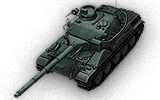Comparing: STB-1 vs. AMX 30 B

In the early 1960s, Mitsubishi started development of a new tank that complied with government requirements for armament and defense. The first two prototypes of the STB-1 were manufactured in September 1969 for trials. In 1970 the prototypes were shown to journalists and participated in a military parade. |

Developed in 1966. The vehicle had maneuverability, engine power, and effective anti-tank engagement distance superior to all other vehicles except the Leopard 1. Great view range allowed the vehicle’s commander to coordinate the actions of the crew and to maintain situational awareness, greatly increasing the vehicle’s effectiveness. The armor of the vehicle was quite thin, but it was decided that technological advances in anti-tank shells had essentially rendered armor obsolete: survivability would depend on mobility and firepower. A total of 2,800 vehicles were manufactured. |
||
| Modules | |||
| Auto select |
|
|
|
|---|---|---|---|
| Turrets | |||
| Guns | |||
| Engines | |||
| Suspensions | |||
| Radios | |||
| Main Characteristics | |||
| Tank data page | Tank data page | Tank data page | |
| Tier | X | X | |
| Battle Tiers | 10 11 | 10 11 | |
| Price | 1 | 6,100,000 | |
| Hit Points | |||
| Signal range | |||
| Speed Limit | 53 km/h | 65 km/h | |
| Speed Limit Back | 20 km/h | 23 km/h | |
| Weight | |||
| Load limit | |||
| Crew |
|
|
|
| Armor | |||
| Hull Armor |
|
|
|
| Turret Armor | |||
|
|
|||
| Mobility | |||
| Engine Power | |||
| Horse power / weight | |||
| Traverse Speed | |||
| Max Climb Angle | |||
| Hard terrain resistance | |||
| Medium terrain resistance | |||
| Soft terrain resistance | |||
| Fire Chance | |||
| Engine Type | |||
| Turret | |||
| View Range | |||
| Turret Traverse | |||
| Traverse Arc | |||
| Armament | |||
| Damage (Explosion radius) | |||
| Penetration | |||
| Shell Price | |||
| Shell Speed | |||
| Damage / min | |||
| Rate of Fire | |||
| Reload time | |||
| Clip | |||
| Accuracy | |||
| Aim time | |||
| Elevation Arc | |||
| Ammo Capacity | |||
| Camo value | |||
| Stationary | % | % | |
| In motion | % | % | |
| When Firing | % | % | |
| Battle performance | |||
| Accuracy | % | % | |
| Neto Credits Income | |||
| Winrate | % | % | |
| Damage dealt | |||
| Kills per Battle | |||
| More stats @ vbaddict.net | More stats | More stats | |